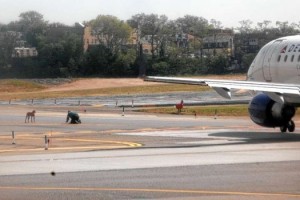Prompted by a scathing audit report by the Transportation Department inspector general about the ineffective implementation of its wildlife hazard plans, the FAA is analyzing comments it received on three draft advisory circulars. One of the ACs is new, but the other two are revisions of existing ACs.
The DOT IG had concluded that the FAA’s oversight and enforcement activities are not sufficient to ensure that airports fully adhere to program requirements or effectively implement their wildlife hazard plans. In addition, the FAA’s policies and guidance for monitoring, reporting and mitigating wildlife hazards are mostly voluntary, thereby limiting their effectiveness.
 For example, the FAA recommends but does not mandate that airports and aircraft operators report all wildlife strikes to the FAA’s strike database. As a result, the agency’s strike data are incomplete, which affects its ability to evaluate the effectiveness of its program in reducing wildlife hazards.
For example, the FAA recommends but does not mandate that airports and aircraft operators report all wildlife strikes to the FAA’s strike database. As a result, the agency’s strike data are incomplete, which affects its ability to evaluate the effectiveness of its program in reducing wildlife hazards.
Finally, the FAA coordinates with the Agriculture Department’s Wildlife Services, its main partner in wildlife hazard mitigation, but its efforts to coordinate with other relevant government agencies are limited and infrequent.
The IG’s report should not have been news to the FAA. In 2009, the NTSB issued a safety recommendation to then-FAA Administrator Randy Babbitt indicating that the FAA should require all Part 139 airports and Part 121, Part 135 or Part 91 Subpart K aircraft operators to report all wildlife strikes, including species identification if possible, to the FAA National Wildlife Strike Database.
The new AC is titled “Protocol for the Conduct and Review of Wildlife Hazard Site Visits, Wildlife Hazard Assessments and Wildlife Hazard Management Plans.” The two revised ACs are “Hazardous Wildlife Attractants On or Near Airports” and “Reporting Wildlife Aircraft Strikes.”
February 4, 2013, 1:20 AM
Read More »



